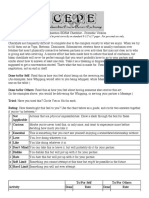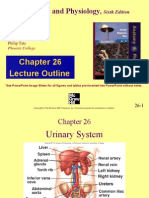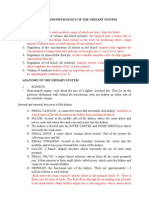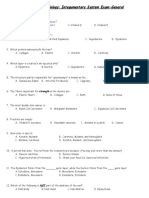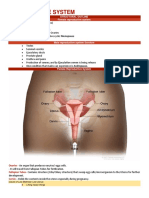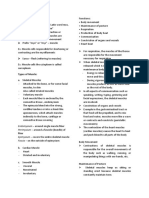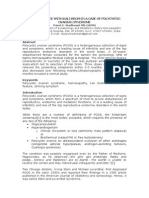Anatomy and Physiology
Anatomy and Physiology
Uploaded by
Aaron Jacob OmañaCopyright:
Available Formats
Anatomy and Physiology
Anatomy and Physiology
Uploaded by
Aaron Jacob OmañaOriginal Description:
Copyright
Available Formats
Share this document
Did you find this document useful?
Is this content inappropriate?
Copyright:
Available Formats
Anatomy and Physiology
Anatomy and Physiology
Uploaded by
Aaron Jacob OmañaCopyright:
Available Formats
Anatomy and Physiology
hypothalamus The hypothalamus is located in the brain, near the optic chiasm. It secretes hormones that stimulate or suppress the release of hormones in the pituitary gland, in addition to controlling water balance, sleep, temperature, appetite, and blood pressure. pineal body The pineal body is located below the corpus callosum, a part of the brain. It produces the hormone melatonin. pituitary The pituitary gland is located at the base of the brain. No larger than a pea, the gland controls many functions of the other endocrine glands. thyroid and parathyroids The thyroid gland and parathyroid glands are located in front of the neck, below the larynx (voice box). The thyroid plays an important role in the body's metabolism. Both the thyroid and parathyroid glands also play a role in the regulation of the body's calcium balance. thymus The thymus is located in the upper part of the chest and produces T-lymphocytes (white blood cells that fight infections and destroy abnormal cells). What are hormones? Hormones are chemical substances created by the body that control numerous body functions. They actually act as "messengers" to coordinate functions of various body parts. Most hormones are proteins consisting of amino acid chains. Some hormones are steroids, fatty cholesterol-produced substances. Functions controlled by hormones include activities of entire organs; growth and development; reproduction; sexual characteristics; usage and storage of energy; and levels of fluid, salt, and sugar in the blood.
adrenal gland The pair of adrenal glands are located on top of both kidneys. Adrenal glands work hand-in-hand with the hypothalamus and pituitary gland. kidney The pair of kidneys are located near the middle of the back, just below the rib cage. The kidneys process the blood to sift out waste products and extra water. This waste and extra water becomes urine, which is stored in the bladder. pancreas The pancreas is located across the back of the abdomen, behind the stomach. The pancreas plays a role in digestion, as well as hormone production. ovary A female's ovaries are located on both sides of the uterus, below the opening of the fallopian tubes (tubes that extend from the uterus to the ovaries). In addition to containing the egg cells necessary for reproduction, the ovaries also produce estrogen and progesterone. testis A male's testes are located in a pouch that hangs suspended outside his body. The testes produce testosterone and sperm.
Function of Pancreas
Insulin and glucagon and their functions related to the maintenance of the blood glucose level
Insulin and glucagon and their functions related to the maintenance of the blood glucose level
Insulin and glucagon and their functions related to the maintenance of the blood glucose level
You might also like
- CEPE Printable BDSM ChecklistDocument17 pagesCEPE Printable BDSM Checklistdeseusnow4980100% (1)
- The Human Body OrientationDocument6 pagesThe Human Body OrientationHenry BuñagNo ratings yet
- Mantoux Test: Pirquet Test, or PPD Test For Purified Protein Derivative) Is A Diagnostic Tool ForDocument5 pagesMantoux Test: Pirquet Test, or PPD Test For Purified Protein Derivative) Is A Diagnostic Tool ForGurmeet SinghNo ratings yet
- ACOG Distocia de Hombros 2017Document11 pagesACOG Distocia de Hombros 2017Clau Alon100% (1)
- Embryology: TeratologyDocument26 pagesEmbryology: TeratologyMielah RuthNo ratings yet
- Sex Positions Master The Climax With Advanced Guided Sex Positions For A Better Sex Life, With Pictures by Bush, MaxDocument87 pagesSex Positions Master The Climax With Advanced Guided Sex Positions For A Better Sex Life, With Pictures by Bush, MaxTaufiq Fahlifi Yfzerobrr60% (10)
- Control of Our Bodies HomeostasisDocument20 pagesControl of Our Bodies HomeostasisJohn Philip VerastigueNo ratings yet
- ANAPHYDocument28 pagesANAPHYAngela SantiagoNo ratings yet
- Anatomical Descriptive Source - Integumentary Skin, Tissue, and CellsDocument6 pagesAnatomical Descriptive Source - Integumentary Skin, Tissue, and CellsGURPARABJOT KAURNo ratings yet
- Chapter 15 - URINARY SYSTEM PDFDocument8 pagesChapter 15 - URINARY SYSTEM PDFRishelle Mae Miñoza PilonesNo ratings yet
- Endocrine System (Midterm)Document6 pagesEndocrine System (Midterm)edceljero127No ratings yet
- Integumentary System OutlineDocument7 pagesIntegumentary System OutlineRogie P. BacosaNo ratings yet
- Endocrine SystemDocument6 pagesEndocrine SystemChechan AmbaNo ratings yet
- ANAPHY LEC PRELIMS NOTES by NOVERO KEN BMLS2 1Document55 pagesANAPHY LEC PRELIMS NOTES by NOVERO KEN BMLS2 1Marcus Randielle FloresNo ratings yet
- Anatomy and PhysiologyDocument3 pagesAnatomy and PhysiologyLorraine Gambito100% (1)
- Anatomy and PhysiologyDocument11 pagesAnatomy and PhysiologyFiona Aaronica Hope Libranda100% (1)
- A&P 302 GI:Digestive System Lecture NotesDocument51 pagesA&P 302 GI:Digestive System Lecture NotesBethanyNo ratings yet
- Anatomy and Physiology,: Lecture OutlineDocument37 pagesAnatomy and Physiology,: Lecture OutlinelouradelNo ratings yet
- Fetal Pig Dissection Lab: Project WeblinkDocument6 pagesFetal Pig Dissection Lab: Project WeblinkJill KoehlerNo ratings yet
- Anatomy and Physiology OutlineDocument13 pagesAnatomy and Physiology OutlineChester RiogelonNo ratings yet
- Anatomy and Physiology of Adrenal GlandsDocument4 pagesAnatomy and Physiology of Adrenal Glandsxxxcamzxxx100% (3)
- Chapter 1 AnaPhy Notes - ReviewerDocument6 pagesChapter 1 AnaPhy Notes - ReviewerDanielle LeighNo ratings yet
- Lecture Outline: See Separate Powerpoint Slides For All Figures and Tables Pre-Inserted Into Powerpoint Without NotesDocument60 pagesLecture Outline: See Separate Powerpoint Slides For All Figures and Tables Pre-Inserted Into Powerpoint Without NotessyafiqahNo ratings yet
- Anatomy and Physiology of The Urinary SystemDocument8 pagesAnatomy and Physiology of The Urinary SystemContented LinganNo ratings yet
- Digestive SystemDocument41 pagesDigestive SystemRotsen B. VelascoNo ratings yet
- The Digestive System: Chapter 23 - Lecture NotesDocument77 pagesThe Digestive System: Chapter 23 - Lecture NotesJonalyn ChewacheoNo ratings yet
- Medication AdministrationDocument67 pagesMedication AdministrationGrajo, Roxanne T.No ratings yet
- CH 39 Acid-Base ElectrolyteDocument16 pagesCH 39 Acid-Base ElectrolyteJonathan EdieNo ratings yet
- BMEN - Digestive System 2020Document76 pagesBMEN - Digestive System 2020OliviaNo ratings yet
- Digestive System - PPT - Nov 27, 2021 ReportDocument23 pagesDigestive System - PPT - Nov 27, 2021 ReportDaniel NapoleonNo ratings yet
- Anatomy and Physiology of The Endocrine System: Presenté ParDocument64 pagesAnatomy and Physiology of The Endocrine System: Presenté ParYackson Frank100% (1)
- Overview of The Immune SystemDocument9 pagesOverview of The Immune SystemAyadi P. AkinwandeNo ratings yet
- Anatomy & Physiology (Chapter 13 - Blood Vessels)Document26 pagesAnatomy & Physiology (Chapter 13 - Blood Vessels)Eliezer NuenayNo ratings yet
- Chapter 1 Anaphy MariebDocument26 pagesChapter 1 Anaphy MariebKeanna ZurriagaNo ratings yet
- The Endocrine System: Part BDocument38 pagesThe Endocrine System: Part BKaly Rie100% (2)
- Integumentary System Test-GeneralDocument5 pagesIntegumentary System Test-GeneralZhedriex EspirituNo ratings yet
- Body TissuesDocument29 pagesBody TissuesPurplesmilezNo ratings yet
- (Week 17) Reproductive SystemDocument3 pages(Week 17) Reproductive SystemDiana Leen Dela CruzNo ratings yet
- Guide Questions AnswersDocument15 pagesGuide Questions AnswersPrancheska Abigayle Peneyra SantiagoNo ratings yet
- (Anatomy & Physiology Lecture) REPRODUCTIVE SYSTEM NOTESDocument21 pages(Anatomy & Physiology Lecture) REPRODUCTIVE SYSTEM NOTESaz.hbizNo ratings yet
- Introduction To AnaPhy Pt. 1Document3 pagesIntroduction To AnaPhy Pt. 1Sofia LozanoNo ratings yet
- Human Anatomy Lecture Notes Update 2017Document58 pagesHuman Anatomy Lecture Notes Update 2017RAGHVENDRANo ratings yet
- Basic Concepts of PharmacologyDocument72 pagesBasic Concepts of Pharmacologynarendra_1983No ratings yet
- Nervous SYSTEM: by Animal Physiology StaffDocument37 pagesNervous SYSTEM: by Animal Physiology StaffSyifarhNo ratings yet
- Abdominal Wall Learning ObjectivesDocument7 pagesAbdominal Wall Learning ObjectivesMadison KommorNo ratings yet
- Muscular System NotesDocument6 pagesMuscular System NotesZussette Corbita VingcoNo ratings yet
- Alteration in Endocrine SystemDocument215 pagesAlteration in Endocrine Systemyen1988100% (1)
- The Respiratory SystemDocument10 pagesThe Respiratory SystemMiguel GumatayNo ratings yet
- Anatomy and PhysiologyDocument61 pagesAnatomy and PhysiologySofiyah Solikah100% (1)
- Lab Report Assistant Endocrine SystemDocument7 pagesLab Report Assistant Endocrine SystemJohn Louis Aguila100% (1)
- Basic Nursing Vital SignsDocument98 pagesBasic Nursing Vital Signsnanakwame5769No ratings yet
- Digestive System Anatomy PhysiologyDocument20 pagesDigestive System Anatomy PhysiologyKids JangNo ratings yet
- Human Anatomy and Physiology: Clarito F. Concepcion Associate Professor 5 CSM, WmsuDocument48 pagesHuman Anatomy and Physiology: Clarito F. Concepcion Associate Professor 5 CSM, WmsuScar Shadow100% (1)
- Anatomy of The Renal SystemDocument67 pagesAnatomy of The Renal SystemRIUNGU PENINAH GATWIRINo ratings yet
- Chapter 8: Nervous SystemDocument15 pagesChapter 8: Nervous SystemAndrea BoocNo ratings yet
- Anatomy and Physiology of BloodDocument10 pagesAnatomy and Physiology of Bloodaoi_rachelle100% (1)
- Impulses Which Are Rapid and Specific and CauseDocument9 pagesImpulses Which Are Rapid and Specific and CauseCellina De LeonNo ratings yet
- Anatomy and Physiology FinalDocument2 pagesAnatomy and Physiology FinalMary Anne Gagarin DomingoNo ratings yet
- 4 - TissuesDocument13 pages4 - TissuesPrince TeodocioNo ratings yet
- SHS The HUMAN BODY An OrientationDocument81 pagesSHS The HUMAN BODY An OrientationRhena Togores100% (1)
- AnP Nervous SystemDocument90 pagesAnP Nervous SystemNicole JohnsonNo ratings yet
- CBSE Quick Revision Notes (Class-11 Biology) Chapter-22 Chemical Coordination and IntegrationDocument3 pagesCBSE Quick Revision Notes (Class-11 Biology) Chapter-22 Chemical Coordination and IntegrationNANDAKUMAR BABUNo ratings yet
- The Endocrine System - Integral PartsDocument3 pagesThe Endocrine System - Integral PartsDavid TanNo ratings yet
- Anatomy and Physiology of Endocrine SystemDocument7 pagesAnatomy and Physiology of Endocrine SystemJumaimah BauloNo ratings yet
- Timetprrrbp O2 Sat Uo BM Ivf NGT HGT Timetprrrbp O2 Sat Uobmivfngthgttimetprrrbpo2 Sat Uo BM Ivf NGT HGTDocument4 pagesTimetprrrbp O2 Sat Uo BM Ivf NGT HGT Timetprrrbp O2 Sat Uobmivfngthgttimetprrrbpo2 Sat Uo BM Ivf NGT HGTAaron Jacob OmañaNo ratings yet
- Victoria's SecretDocument3 pagesVictoria's SecretAaron Jacob OmañaNo ratings yet
- Patho PancreatitisDocument2 pagesPatho PancreatitisAaron Jacob OmañaNo ratings yet
- Nursing Care PlanDocument7 pagesNursing Care PlanAaron Jacob OmañaNo ratings yet
- NP2 Nursing Board Exam November 2008Document16 pagesNP2 Nursing Board Exam November 2008Clarissa GuifayaNo ratings yet
- Artificial InseminationDocument7 pagesArtificial InseminationReon WhyteNo ratings yet
- One Summer NightDocument40 pagesOne Summer NightJarnGarmrNo ratings yet
- 0610 m18 3 2 QPDocument20 pages0610 m18 3 2 QPChrystal BrownNo ratings yet
- Pretoria Central +27833736090 DR. JABULILE/abortion Pills 4 Sale in Pretoria ClinicDocument31 pagesPretoria Central +27833736090 DR. JABULILE/abortion Pills 4 Sale in Pretoria Clinicsseruwagi miyodiNo ratings yet
- Andre Si Anak Cerdas Yang Sempat Hilang IngatanDocument3 pagesAndre Si Anak Cerdas Yang Sempat Hilang Ingatanhisar2104No ratings yet
- OBS Scanning ProtocolDocument15 pagesOBS Scanning Protocoltafi66100% (1)
- AnswersDocument19 pagesAnswersSherlock Wesley ConanNo ratings yet
- My Experience With Kali Brom in A Case of Polycystic Ovarian SyndromeDocument6 pagesMy Experience With Kali Brom in A Case of Polycystic Ovarian SyndromeHomoeopathic Pulse100% (1)
- DysmorphologyDocument16 pagesDysmorphologycoassukoyNo ratings yet
- Obstetrics OverviewDocument91 pagesObstetrics OverviewAbi TudNo ratings yet
- Paecilomyces LilacinusDocument25 pagesPaecilomyces LilacinusShashi Sharma100% (3)
- Ovarian Carsinoma: Divisi Onkologi Ginekologi Bagian Obstetri & Ginekologi FK - UsuDocument25 pagesOvarian Carsinoma: Divisi Onkologi Ginekologi Bagian Obstetri & Ginekologi FK - UsuThe Ray MedicsterNo ratings yet
- Birth InjuriesDocument9 pagesBirth InjuriesshailaNo ratings yet
- Rights of Unborn ChildDocument17 pagesRights of Unborn ChildAnonymous 2UPF2xNo ratings yet
- R.A. No. 10354Document24 pagesR.A. No. 10354Leoni MesaRioNo ratings yet
- Urethritis PPT FatihDocument31 pagesUrethritis PPT FatihradityafatihNo ratings yet
- Biotech Reviewer PDFDocument31 pagesBiotech Reviewer PDFGerald LimNo ratings yet
- Fab RoidsDocument2 pagesFab RoidsRashid MahmoodNo ratings yet
- Chapter 1 Introduction To Biology: Analysing The Role of Hormone in HumansDocument8 pagesChapter 1 Introduction To Biology: Analysing The Role of Hormone in HumansHamirah Abd HamidNo ratings yet
- Why Planned Family Is ImportantDocument3 pagesWhy Planned Family Is Importantshruti singhNo ratings yet
- Rajiv Gandhi University of Health Sciences, Bangalore, Karnataka, Annexure-Ii Proforma For Registration of Subjects For DissertationDocument14 pagesRajiv Gandhi University of Health Sciences, Bangalore, Karnataka, Annexure-Ii Proforma For Registration of Subjects For DissertationJyotiNo ratings yet
- q3 Science 10 w1Document5 pagesq3 Science 10 w1Kimi LegsonNo ratings yet
- Student EDITION VariationDocument10 pagesStudent EDITION VariationChepora NorieNo ratings yet
- NCM107 Lecture 1 Framework of MCNDocument3 pagesNCM107 Lecture 1 Framework of MCNChristian Karl Joshua RamosNo ratings yet
- Fisiologi MenstruasiDocument3 pagesFisiologi MenstruasiSyahnaz Mardiah AlkatiriNo ratings yet
